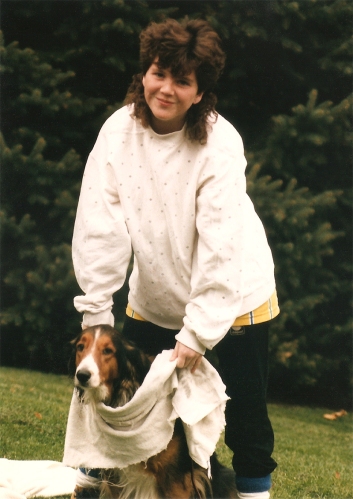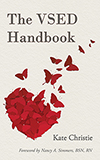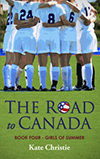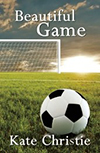So there’s a time in my life that I don’t like to think about, let alone talk or write about. But I recently wrote a YA novel about a pair of high school soccer players, and I discovered that inhabiting their minds for months on end brought me spiraling back to my own teenage-hood, better known as the years-long period of my life when I felt actual despair. Hopelessness, even. Like my character Jamie, if not for soccer, if not for the endorphins, the team goals, the chance to inflict my anger and frustration legally and with encouragement on a small leather ball and larger, less leathery opponents, I honestly don’t know how I would have made it through junior high and high school.
I’ve heard a lot of people say they hated their secondary school experiences, including my own sister. It’s not something we talk a lot about, but as a teenager, my older sister struggled with suicidal ideation, much of it revolving around the two-year relationship she had with another girl. I found out about my sister’s girlfriend from Aaron (not his real name), one of the identical twins who lived in my neighborhood. Aaron was the more dynamic of the two boys, i.e. the one who suggested he and his twin Adam switch clothes and classrooms every so often in elementary school. We could all tell them apart, of course, but the adults? Not so much.

Rocking the pageboy in the early 198os.
Aaron was also the boy who, in seventh grade, announced to the lunch table that my older sister was a “dyke.” Apparently he’d forgotten the reputation I’d made for myself in second grade when I beat the crap out of any boy who dared steal my soccer ball or put me down for being “just a girl.” I mean, it had been five years, so maybe his memory lapse was understandable. Or maybe he just thought that now that we were in junior high, I would act more like a “regular” girl and less like a tomboy, despite the fact I favored tube socks, Puma sneakers, and a Kate Jackson pageboy haircut.
Either way, he seemed to realize his mistake almost immediately, because as my fists clenched and my eyes narrowed to slits, his eyes widened and he backed away.
“Take it back!” I roared, pushing away from the lunch table.
That’s when he made his second mistake: He whirled and ran. Like a wild cat, I growled and chased after him, my adrenaline surge fueled by his frenzied flight.
The chase was pathetically short. Aaron had quit soccer long before and was more interested in video games and (though I didn’t know it then) smoking weed with a few other future wake-and-bakers in the neighborhood, whereas I was still fully soccer-obsessed and a member of the Hillside Junior High track team. I caught him in the courtyard outside the lunchroom, tackled him to the ground, and sat on him, yelling at him to take it back. Naturally, he did.
Our friends followed us, and when a monitor finally picked up on the disruption in the lunchroom force, our friends pulled us apart and we all retreated as if nothing had happened. At least, outwardly. For the next few days, though, I walked through the school halls with a question battering my brain: “Was she?” And even more disturbing, “Am I?” By then, I already knew I was different. I’d known for a while, but junior high was where my difference became more pronounced because not only did I have crushes on girls more than on boys, I was still a tomboy—i.e., resolutely gender non-conforming, although more out of cluelessness than choice. My female friends had recently begun to speak what seemed to me almost a foreign language revolving around boys and make-up as they worked to fit themselves into a traditional gender role I couldn’t begin to fathom. It probably didn’t occur to Aaron that I would kick his ass at lunch because, duh, I was a girl, and girls in junior high don’t usually seek to dominate their male classmates either physically or academically. Second grade, sure. But seventh grade? My reaction marked me as an outlier even as it reinforced my schoolyard rep as someone not to be messed with.

My sister (center left) and me in the late 1980s
My sister, who identifies as bisexual, and I, a genderqueer lesbian, both came of age in the 1980s, when homophobia in American culture was dishearteningly mainstream. Unfortunately, thirty years later, the “taint” of queerness in sexual orientation and gender presentation is something American kids still struggle significantly with. In fact, according to the Trevor Project, suicide is the second leading cause of death among young people ages 10 to 24, and LGB youth are 4 times more likely to attempt suicide than straight youth. Other disturbing statistics from the Trevor Project: Nearly half of young transgender people have seriously thought about taking their lives, and 25 percent report having made a suicide attempt. Each episode of LGBT victimization, such as physical or verbal harassment or abuse, increases the likelihood of self-harming behavior by 2.5 times on average.
The Dangers of Being Queer
There’s a reason for the tendency toward self-harm and the marked lack of resilience among our community’s youth. Members of other minority groups can usually rely on a support system made up of friends and family who in many cases share their minority status and who love them unconditionally, but kids who are queer fear they will never find a place where they can be accepted for being their authentic selves. Those of us in the LGBT community don’t know who will respond positively until we make the decision to be honest with the people in our lives—or someone else makes that decision for us. Coming out always means running the risk of being ridiculed and ostracized by childhood friends and, even worse, family members.
We’ve made enormous progress in the decades since I was a teen, thanks to LGBT civil rights activists and to campaigns like the It Gets Better Project, which works to communicate to LGBT youth that even if their families and communities of origin reject them, there will be other places where they will be loved and accepted, and other people who will cherish them. But despite our many steps forward, half of all queer teens still get a negative reaction from their parents when they come out to them, according to the True Colors Fund. More than 25 percent are thrown out of their homes, and still others run away to escape an abusive environment. Right now, LGBT youth—who represent around 7% of the American youth population—make up an estimated 40% of the 1.6 million homeless young people living on the streets. Despite their minority status, LGBT youth are nearly eight times more likely to wind up homeless than their straight counterparts, a situation that puts them at an increased risk of victimization, sexual and physical assault, and mental health issues.
Public schools in the U.S. have made significant advances against LGBT bullying, too. When news of my sister’s relationship with her girlfriend got out at Kalamazoo Central High School, she was harassed on a daily basis in hallways, bathrooms, and classrooms while the school’s teachers and administration largely looked the other way. But while LGBT verbal and physical bullying has, unfortunately, survived the test of time and has even evolved in sophistication via social media, schools have become better at both prevention and intervention. A couple of years ago when GLSEN released the 2013 National School Climate Survey, their 8th biennial report on the school experiences of LGBT American youth, they noted that even though LGBT students continue to experience pervasive harassment and discrimination, an increase in the availability of school-based resources and support is making American public schools safer overall.
Getting Out

Me & Bandit (& my perm!) in high school
But school—and home life—is still not safe for so many LGBT youth. Rejection from families of origin and “pervasive harassment and discrimination” are not easy things to bounce back from, no matter how much support teachers and administrators extend. After witnessing my sister’s experiences at the hands of Kalamazoo Central bullies, I retreated into myself, focused on soccer and schoolwork and writing, and, in a 1980s version of It Gets Better, basically waited out high school. Leaving my family and hometown behind was, I imagined, the only way I could ever find true happiness. Or if not happiness, then some sort of contentment. I pictured my adult self living alone in a cabin in the woods where I would have my dogs and my books and my fictional characters for companionship. It would be a quiet life without a spouse or children; a blessedly (or so I thought) empty life where I wouldn’t have to worry about being despised for who I happen to be.
Seeking solitude as a teenager wasn’t a blessed experience, though. It was incredibly lonely. Whenever anyone reached out to me, I responded only half-heartedly. I was so afraid of being rejected, so far inside my own head and heart it would have taken someone incredibly strong and dedicated to break down my defenses. I told myself I was happy being alone, and honestly, it was often a relief to roam the woods near my house with just my dog at my side; a relief to play soccer alone in my old junior high schoolyard after everyone had gone home for the day. I studied hard and watched tons of television and read romance and science fiction and fantasy novels, anything to distract me from my daily life. And I waited.
With all that studying, I did well academically. Soon colleges were lining up for me, and I knew that my dream of escape was within reach. I visited schools, read view books, and listened to my gut, and somehow I managed to pick wisely: Smith College in Western Massachusetts, an all-women’s school eight hundred miles away from my Southwest Michigan hometown. Smith’s view book contained a handful of photos of smiling tomboys in among the “regular” girls, including a picture on the back cover of two athletes walking down a brick path casting wide smiles over their shoulders, autumn leaves swirling around them, an ivy-colored building in the near distance. In that image I saw the possibility of being accepted and no longer alone. Maybe even, dare I think it, happy? When I visited Smith in Northampton, Mass. (a.k.a. Lesbianville, USA), I knew I was on the right track. Soon, it would get better for me.

Smith College, where (for me) It Got Better
And yet it took a full year for my heart to thaw, an entire year at Smith wondering if I could put myself out there, if anyone would like me if they got to know the real me. Not until my sophomore year did I gain enough courage to cut my hair short and match my outsides to my insides, to come out far and wide as a gender non-conforming lesbian. As soon as I did, an amazing girl asked me out. She thawed my frozen heart the rest of the way, and though I imagine she probably grew frustrated having to battle my walls and the emotional iciness I retreated into whenever I felt threatened, she was more than generous with her patience and unconditional love. We were together for a year during which my old dream, of solitude and dogs and loneliness, faded completely away, overtaken by visions of a partner and home and even, maybe someday, children. My parents adored her, and even after we broke up (alas, she graduated and I didn’t), they continued to ask about her for years. Once, I asked my mother why, and she told me that my relationship with my first girlfriend made me a more open and loving person, for which my parents will always be grateful.
Twenty-five years later, I am not the same teenager who left home wondering if I would ever find a place to belong. And yet, somewhere inside of me is that broken girl, that scared girl, that hopeless girl. Sexuality isn’t everything, of course; it’s just a part of who we are. But if your sexuality and/or gender identity fall outside cultural norms, they become objects others can and do use to hurt you, to ridicule you, to chip away at your sense of self. To beat you down, figuratively and sometimes literally. They become the reason your family might stop loving you, the reason your best friend from childhood might turn away from you, the reason your teachers might withhold help and acceptance, the reason your church might mark you as a sinner unworthy of your god’s love.
The majority of queer youth still struggle with these and other “what if” moments because most queer youth still come from straight parents who are statistically just as likely to ban them from dating anyone of the same sex or kick them out–or force them into “conversion therapy”–as they are to unconditionally love and accept them for having the courage to be themselves.
And yet, it does get better. There are an estimated 3,000 school-based Gay Straight Alliance clubs across the U.S., and even more opportunities for queer youth to connect online. It does get better, and it has gotten better over the last few decades. My hope, along with that of so many other LGBT adults, is that it will continue to do so.
My vlog for the It Gets Better Project is below. If you watch it, try not to laugh at the additional permed mullet pics from the (thankfully) distant 1980s–I dare you…























Junior high was just awful, wasn’t it? Your sis definitely helped me feel like a person in high school, since she sort of adopted me my freshman year. Having a gay mom and sister and not being able to talk about it was incredibly stressful during those years and I am so incredibly thankful that your daughters won’t ever have to experience that need to operate under the radar. I wish we could have been more open with each other.
Junior high really was the worst. Although I met you and Hilary then, so it wasn’t a total loss! I still look back on our KATAG days as an absolute highlight of my early education not just for the intellectual challenge but also for the quirky company. I always felt so boring compared to you guys, but lucky to be around such creative individuals.
I’m glad my sis was able to be there for you. I can imagine the stress of having a different family structure in those days of compulsory conformation… I wish we could have connected more then, too, but I wasn’t much use to anyone back then, not even myself. Sometimes I wonder what I was so afraid of. Other times I remember precisely where the fear came from. This week has been one such reminder. It’s almost a worse feeling to have come so far and then be faced with such a giant cultural setback. But I have hopes that the setback is only that–a temporary reversal typical in times of great forward progress. I have hopes…
Hope you’re doing okay down south in red territory. Fingers crossed for–well, I don’t know what, exactly. Something better than this awful week, I suppose.
What a great post – I had never heard of the project. Hope is one of the greatest gifts we can give and God knows its the only thing I’ve lived on several times in my life. — I found your blog via Bella Books and have enjoyed reading through it. Thanks for taking the time to post so much – including your kids’ book recommendations (which are hard to come by). Also appreciate your candor on parenting multiples. Makes me feel a little more sane. You married one of the coolest women I have ever known – so happy to see you guys happy. 🙂
Hi! Thanks for commenting on the blog. So cool that you found me (and Kris!) through Bella Books. Glad you enjoy the posts. And yeah, I know what you mean about kids’ book recs. They really are hard to find! Happy reading. 🙂 KJC